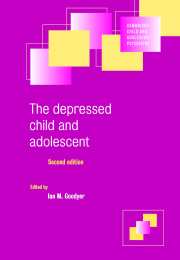Book contents
- Frontmatter
- Contents
- List of contributors
- Preface
- 1 Historical aspects of mood and its disorders in young people
- 2 The development of emotional intelligence
- 3 Developmental precursors of depression: the child and the social environment
- 4 Physiological processes and the development of childhood and adolescent depression
- 5 Childhood depression: clinical phenomenology and classification
- 6 The epidemiology of depression in children and adolescents
- 7 Family–genetic aspects of juvenile affective disorders
- 8 Life events: their nature and effects
- 9 Adolescent depression: neuroendocrine aspects
- 10 Suicidal behaviour in adolescents
- 11 Psychopharmacology of depressive states in childhood and adolescence
- 12 The psychotherapeutic management of major depressive and dysthymic disorders in childhood and adolescence: issues and prospects
- 13 Natural history of mood disorders in children and adolescents
- Index
9 - Adolescent depression: neuroendocrine aspects
Published online by Cambridge University Press: 18 December 2009
- Frontmatter
- Contents
- List of contributors
- Preface
- 1 Historical aspects of mood and its disorders in young people
- 2 The development of emotional intelligence
- 3 Developmental precursors of depression: the child and the social environment
- 4 Physiological processes and the development of childhood and adolescent depression
- 5 Childhood depression: clinical phenomenology and classification
- 6 The epidemiology of depression in children and adolescents
- 7 Family–genetic aspects of juvenile affective disorders
- 8 Life events: their nature and effects
- 9 Adolescent depression: neuroendocrine aspects
- 10 Suicidal behaviour in adolescents
- 11 Psychopharmacology of depressive states in childhood and adolescence
- 12 The psychotherapeutic management of major depressive and dysthymic disorders in childhood and adolescence: issues and prospects
- 13 Natural history of mood disorders in children and adolescents
- Index
Summary
Introduction
The development of criterion-based diagnostic systems has been an impetus for the investigation of the neurobiological underpinnings of psychiatric disturbance in children and adolescents. Although, to date, insufficient knowledge exists specifically to identify the aetiologies of various disorders, studies of clinical and normative populations have led to a veritable explosion of knowledge about the neuroendocrine aspects of psychiatric disorders. As a result of these investigations, the specificity of current diagnostic systems has been questioned, the pathophysiology of various psychiatric disorders has been explored and simplistic models which previously have been invoked to explain both normal and pathological behaviour (for example: adolescent turmoil is due to hormones) are no longer tenable (Buchanan et al., 1992).
Neuroendocrine studies in adolescent depression have arisen from the influence of similar research in adult populations, and some of the earliest work in this field was an attempt to determine if the neurobiological features found in adult depressives would also be present in children and adolescents. Similar findings, it was argued, would provide further evidence for the presence of depressive disorders in younger populations and thus lend credibility to the diagnostic classification of child and adolescent depression. This work of pioneering investigators has been further developed by the realization of the different central nervous system (CNS) and neurohormonal aspects of adolescents compared to adults (Buchanan et al., 1992).
Furthermore, adolescent neuroendocrinology, with its developmentally determined differences that occur rapidly during a few years of the life cycle, give an added dimension of complexity that is not usually addressed in studies of adult populations.
Keywords
- Type
- Chapter
- Information
- The Depressed Child and Adolescent , pp. 233 - 266Publisher: Cambridge University PressPrint publication year: 2001
- 1
- Cited by



